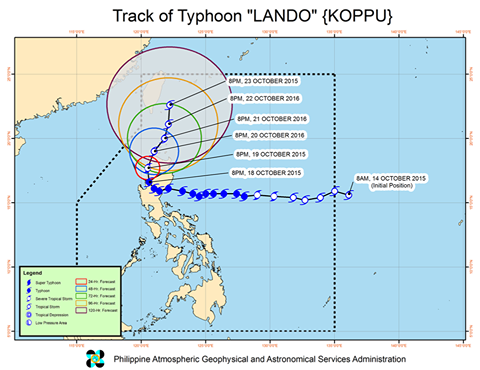TYPHOON “Lando” (international name Koppu) has weakened while moving slowly toward the regions of Cordillera and Ilocos, and the number of provinces placed under Signal No. 3 was reduced from 11 to five, the Philippine Atmospheric, Geophysical and Astronomical Services Administration (Pagasa) said late Sunday night.
In its bulletin issued at 11 p.m., Pagasa said that at 10 p.m. Sunday the center of the typhoon was located near Tinoc, Ifugao (16.7°N, 120.9°E).
It has maximum sustained winds of 130 kilometers per hour near the center and gustiness of up to 160 kph. moving north-northwest at 5 kph.
Under public storm warning Signal No. 3 are Benguet, Ilocos Sur, La Union, Ilocos Norte and Abra, Pagasa said.
Signal No. 2 is hoisted in Pangasinan, Zambales, Nueva Vizcaya, Ifugao, Mountain Province, Kalinga, Apayao and Tarlac, forecasters said.
Signal No. 1 is up over Bataan, Pampanga, Bulacan, Nueva Ecija, Northern Quezon, Quirino, Aurora, Isabela, Cagayan including Calayan and Babuyan group of Islands, Batanes and Metro Manila, they added.
At least two people died in the onslaught of Lando, and authorities reported that the typhoon displaced 16,000 villagers and knocked out power in many northern Luzon provinces.
Meanwhile, Nueva Ecija Governor Aurelio Umali confirmed Sunday that two persons were found dead floating in flood waters in Palayan City, the capital of the province.
The victims were not yet identified.
Army troops and police were deployed to rescue residents trapped in flooded villages in the hard-hit provinces of Aurora, where the typhoon made landfall early Sunday, and Nueva Ecija, a nearby rice-growing province where floodwaters swamped rice farmlands at harvest time.
After slamming into Aurora’s Casiguran town after midnight Saturday, the typhoon weakened and slowed down, hemmed in by the Sierra Madre mountain range and a high pressure area in the country’s north and another typhoon far out in the Pacific in the east, government forecaster Gladys Saludes said.
Howling winds knocked down trees and electric posts, leaving nine entire provinces without power, while floods and small landslides made 25 roads and bridges impassable. Authorities suspended dozens of flights and sea voyages due to the stormy weather, and many cities canceled classes on Monday.
By Sunday afternoon, the typhoon had veered toward the north from a westward course and was barreling across mountainous Nueva Vizcaya province with sustained winds of 150 kilometers (93 miles) per hour and gusts of up to 185 kph (115 mph), according to the government’s weather agency.
Satellite images showed that the typhoon appeared to be losing its eye, a sign of its dissipating strength, acting weather bureau chief Esperanza Cayanan said, adding that Lando was forecast to move at a slow pace of 5 kph (3 mph) across the mountainous north before exiting the main northern island of Luzon on Wednesday.
While weather conditions had begun to improve in some towns, and villagers had started to clear roads of fallen trees and debris, Koppu still packed a ferocity that could set off landslides and flash floods, officials said.
“We’re asking our countrymen not to become complacent,” said Alexander Pama, who heads the government’s disaster-response agency, citing how rainwater could cascade down mountainsides after Koppu passed and flood villages.
That happened in low-lying villages in six towns in Nueva Ecija, near Aurora, where some residents were trapped on rooftops by floodwaters, said Nigel Lontoc of the Office of Civil Defense.
A teenager was pinned to death on Sunday by a fallen tree, which also injured four people and damaged three houses in Quezon City. In Subic town, northwest of Manila, a concrete wall collapsed and killed a 62-year-old woman and injured her husband, Lontoc said.
Three fishermen who had gone missing at sea were rescued off northern Bataan province, and three other missing people were found in an evacuation camp in Aurora’s Baler town, he said.
President Benigno Aquino III and disaster-response agencies had warned that Lando’s rain and winds may potentially bring more damage with its slow speed. But Saludes, the government forecaster, said that there was less heavy rain than expected initially in some areas, including in Manila, but that fierce winds lashed many regions.
